
How to identify roman coins
Before starting, I remind you that you have the tool "image search engine" https://www.all-your-coins.com/en/search-by-picture/romaines-167/" for already identify the emperor and the type of reverse. The associated legends for each emperor and each type. Full details about ho to use it, here: https://www.all-your-coins.com/en/blog/antique/comment-utiliser-le-moteur-de-recherche-par-image. All illustrated coins are with copyright photo permission of : Numismatica Ars Classica. Link to their website: http://www.arsclassicacoins.com/. Except for those with mention.
Summary:
- Descriptives terms used.
- Clothes, crowns and busts orientations.
- The objects held by the emperor.
- Read and understand legends and marks.
- Read a legend.
- Mint marks.
- Denominations and their history.
- Allegories and divinities.
- Striking techniques and accidental strikes.
- Hybrids
- Incuses strikes.
- Shocked dies.
- Broken dies.
- Blocked dies.
Blanks errors
- Homogeneity errors with mixture metals.
- Double weights.
- Mints and their marks.
- Provincial coins.
- States of conservation.
- Books and their references.
Descriptives terms used
When you discuss with collectors you will speak of "legend" which is also called "titulature" to describe the words and abbreviations inscribed on the currency. We will speak of the "field" of the currency designating the smooth and unregistered part. The grenetis refers to the small dots around the coin (see photo). The bust obviously indicates the portrait and implies the description of the clothes, crowns, jewels and items. If anyone asks you what is the bust of the coin, he does not wait for you to give the name of the emperor, but: the crown, the cloth... and even the orientation. For the example in the photo below, the Emperor Britannicus has a "bust bareheaded, draped and turned left".
To complete, a word will be meet for several different elements, it is the word "type". I want to make a specific part on this subject because the use of this word is difficult for beginners and even sometimes for advanced collectors. Indeed, we say "type of money" which refers to the denomination (denarius, sestertius...) but also the "type" which indicates the character of reverses. Still looking at the photo below, the character of the reverse (character right) being PAX we speak of a sestertius PAX type. This way of speaking of "type" for two different things is common and if you do not pay attention, you will talk about something with your interlocutor while he is talking about something else. Remember to clarify or ask for clarification. "What kind of coin do you trade?" your answer: "You speak of the denomination or the reverse?", your interlocutor will answer you perhaps "I speak of the type of reverses, because I collect only the coins of the LIBERTAS type".
Finally, before seeing the picture illustrating my words so far, I spare you the word "slice" as it is obvious, but I still talk about it because yes, you may have to talk about the slice of an ancient coin. For example, if you are discussing the authenticity of a coin, the slice can be a determining factor. Note also the word "blank" which names the piece of metal that has been struck. Therefore, why talk about it? A simple example: your coin has a broken part? Therefore you say "sestertius with broken blank". This term blank, allows, to speak precisely of the state of origin of the coin. The break was already present at the time of the strike? Or is it due to a "modern" blow and therefore to wear?
Below the picture I'm talking about since the beginning of this chapter and showing you the terms to remember in priority:
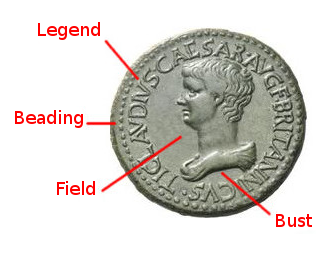
Clothes, crowns and busts orientations
Let's go a little deeper about busts. Here is a chart showing you the most common types of crowns and clothes:
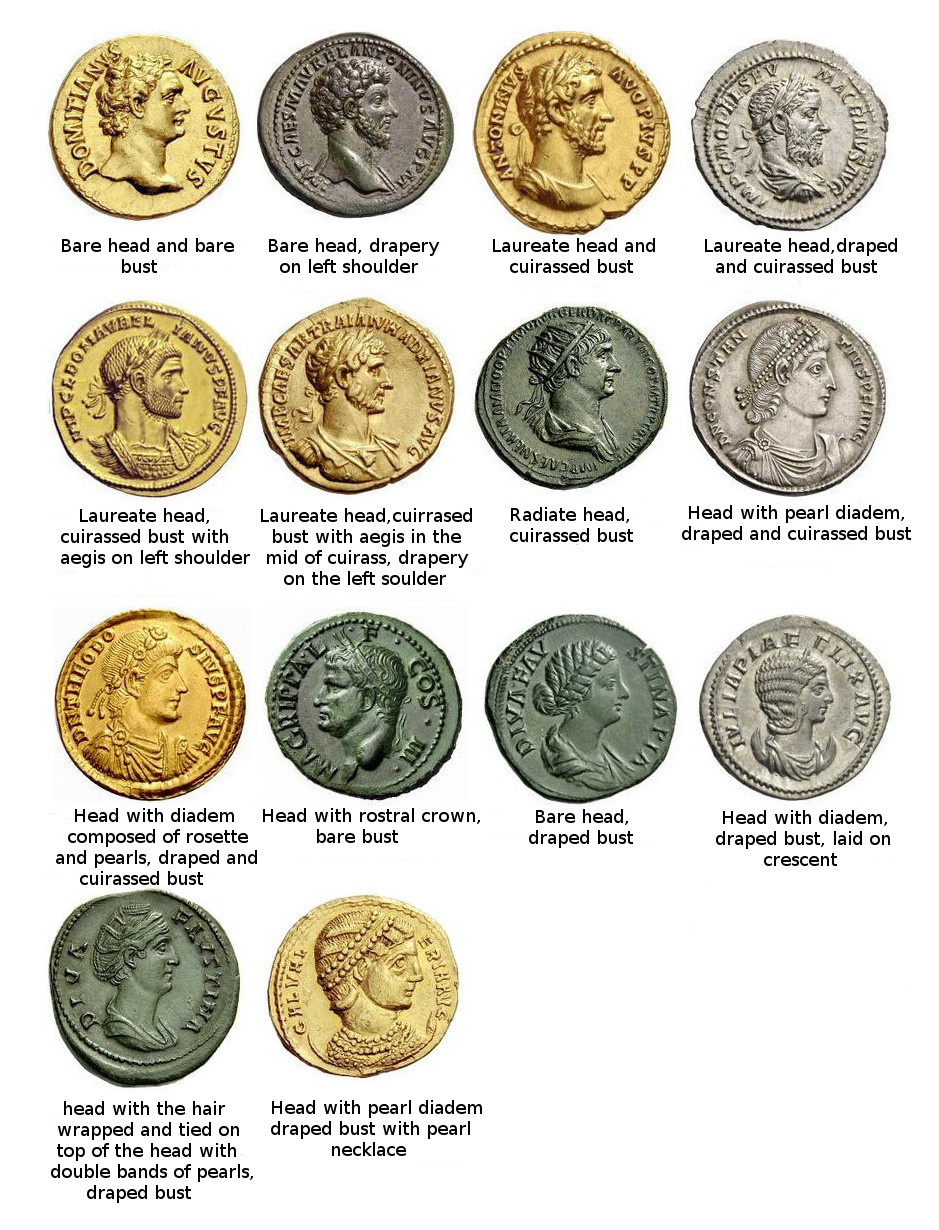
At the point where you are, how to differentiate a draped bust of a draped bust and cuirassed? You must see a piece of cuirass appear as the breastplate, the place to look in priority is the shoulder that is at the front of the drawing. If you look at the fourth coin you will see the shoulder armor of the cuirass. We can also distinguish the belt that most often comes out of the drape in the case where there is a drape above the cuirass. This belt is seen on the sixth coin of the painting. If you see a face, a horse, or any other representation on the bust is that a cuirass is present.
We can push the description to describe the fibulae if they are present, as on the coin number 9. If you browse my database, you will see that I describe the shape of these fibulae. Noting everything is important and as I said in other articles, this is useful especially in the context of a work of identification of the die links.
It lacks some crowns much rarer that I did not choose to illustrate in this table showing the types of crowns and clothes that we meet most often. For example the crown of reeds:
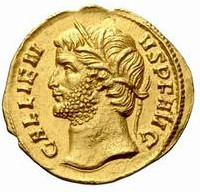
We meet this crown extremely rarely! We meet still more often but all the same rarely (except in the coins of the Republic where they are common), the character who is "turetted" here is the crown:
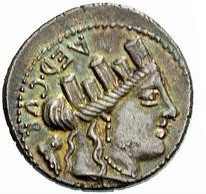
It is also a republican coin which is illustrated, however the characters of the reverse can have crowns. In this case, the crown shaped towers, called "mural" is much more common from the third century, but only for allegories or deities. Finally, the obsidional crown for emperors is not illustrated for two reasons: rare and I could not find a photo of one of these crowns which I obtained the copyright. If you have one and want to send it to me, thank you.
Here is a description of known crowns:
- The Civic Crown: It consists of two branches of oak, and was given to the one who had saved a citizen and killed his aggressor. The bearer of this crown was exempt from taxation. It is most often seen alone and surrounding a legend, but it can also be found on the head of an emperor.
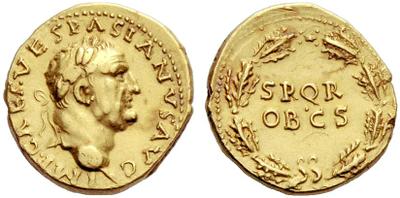
- The Naval Crown or Rostral: Golden crown decorated with rostrums that is to say the spurs that were at the front of the ships and used to sink the prows. It was awarded to the winner of a naval battle, to the one who was the first to board a ship. Very rarely met on the head of another emperor than Agrippa.
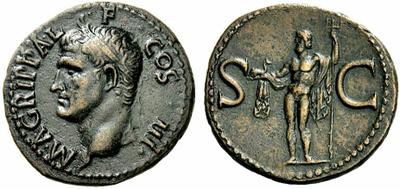
- The Triumphal Crown: It is the crown of laurels that we see on almost all Roman coins. It is composed of two branches of laurels and was awarded to the victorious generals of great battles, carried in triumph. It was handed over to the Emperor upon his accession to the title of IMPERATOR. it comes from the myth of Daphne and was already used by the Greeks. It is tense very often by the allegory of Victory.
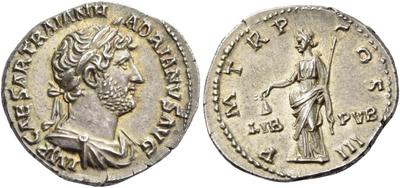
- The Radiated Crown: It also presents at the time of the Greeks, it symbolizes the immortality and the divination of the emperor. It was composed of spikes, it is the same crown that carries Sol. In the mintage, it appears on the heads of living emperors, example with Postume, or on the heads of dead emperors with legends such as: MEMORIA FELIX, DIVO, PIO etc ...
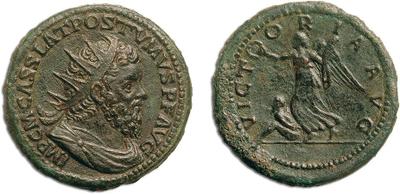
- The diadem: Originally it was a headband. Later, during the lower Roman Empire, it is adorned with stones. We often find a square or round tip, consisting of one or more stones. We also see the ends of the diadem falling on the shoulders of the emperor and which are stones (small balls). However these "balls" are not necessarily a sign of presence of diadem, they are also found on the laurel wreaths. Sometimes it is composed of leaves and stones, it can be confused with a laurel wreath. For the example below, I chose a coin of Constantine I where we see a simple banner. You have an example of a diadem made of stones in the table of crowns and clothes just above this subchapter.
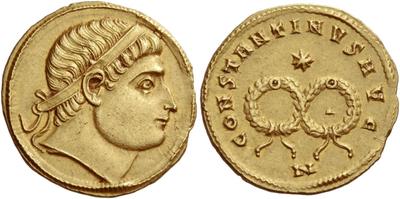
- The Walled or Turreted crown: A golden crown made up of towers representing the fortifications of a city. One often meets her on allegories like ORIENT and on the head of characters (Tyche) representing a city like the Tyche of Antioch for example. Surrender to the one who crossed a wall first. The Vallaire crown was handed over to the person who had climbed the palisade of a camp. It is the goddess Cybele who is associated with this mural crown, since the time of the Greeks. The example below shows this crown on the head of the character on the right, being a variant of the one already shown in the table at the very beginning of the chapter..
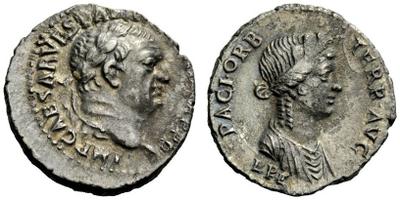
- The Obsidional or Graminal Crown: Composed of grasses and given to the one who had saved an army of a seat. We can see an allusion of the care. The herbs that compose it are those found on the battlefield. Its name comes from "Obsidio" which means seat. No picture available.
Now what is missing? The orientation of the bust: Is it from the front, turned left, turned right? Even if one simply notes these orientations, it is sometimes necessary to note also their degree. Example: bust turned right seen three quarters forward (A). I will not go into the description of each specific direction for several reasons that I detail here: you need to be "specialist", you must have great knowledge and experience to note these directions. Why is it so complicated? Simply because the roman engravers were not well acquainted with the representation of perspective. And, still more, these variations intervene in their quasi completeness in the period of the low empire, exactly, to a period where the quality of typing and engraving is decreasing: one makes much more use of engravers "barbarians ", illiterate and inexperienced. It sometimes happens, therefore, to meet the most common bust, said "seen three quarter ahead" with an emperor showing us his two shoulders forward, where in any case what it seems to be represented. These things are just clumsy engravings and are excluded from voluntary variants that are to be noted and referenced. Moreover, where there is still a complication, it is that in order to determine these orientations, we must know our subject perfectly and know how to look at each element of the drawing, where the belt is in relation to the rest of the body. Do we see shoulder pads in part or completely? While taking into account the problems of perspective ... These orientations of busts are often accompanied by letters and figures, like A 1 or O etc ... These references refer to books, most of the time to the Roman Imperial Coins ( RIC) I will detail these references below in the article through a chapter dedicated to it. Be careful though, everyone has their own reference books, if you describe an orientation via a letter and a number, remember to note the book you are referring to. Otherwise you risk creating confusion if the reader thinks of another book.
Finally, we must also distinguish the clothes, for example a consular dress of a simple drapery. The emperor can be dressed in a toga as we often see on the reverse of a coin. Below, a consular habit found on the obverse with the portrait of Emperor Constantius II and on the reverse as a whole with the emperors Constantius II and Constans, both in consular dress.
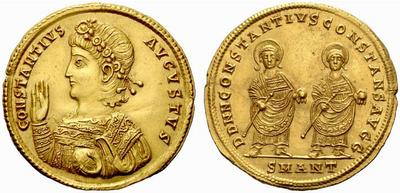
The objects held by the emperor
I will detail here the main objects held by an emperor, knowing that he can hold several at the same time. Likewise, in addition to objects, we can see a horse, a hand ... appear with the portrait. I speak on the side of the coin to the portrait of the emperor (obverse). Otherwise, the emperor may appear on the reverse of a coin, usually standing, with the entirety of his visible body, holding, for example, a standard, a spear ... We can also see him on horseback, in a chariot , seated ... Here is a list of the main objects held by the emperor that you often meet:
- A globe.
- A statuette.
- A roll.
- A scepter.
- A cross.
- A scipio.
- A spear.
- A shield.
- A rein for horse.
- A "mappa".
- A parazonium.
The scipio is a kind of scepter with an eagle represented at its top. The parazonium is a small sword. We note here that for example, a globe can be surmounted by a statuette. Here are some photos, showing you these objects:
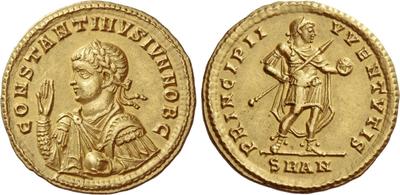
The emperor Constantine II holding a globe with the left hand.
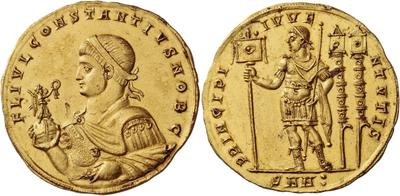
The emperor Constantius II holding a nicephore globe (because there is a statuette of victory on the globe) with the right hand and a sword with a handle in the shape of an eagle's head in the left hand.
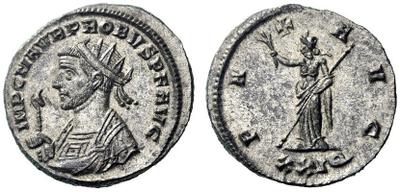
The emperor Probus, holding a scipio (also called eagle tipped scepter) in the right hand.
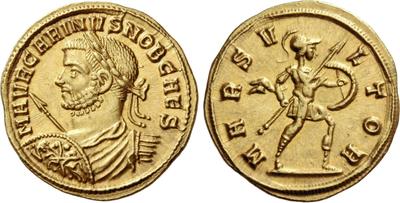
The emperor Carinus holding spear and shield. As Mars on the reverse.
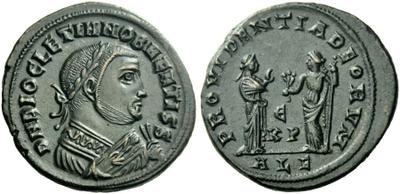
the emperor Diocletian holding a mappa in right hand.
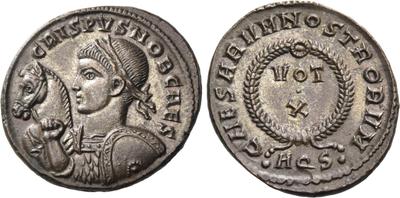
The emperor Crispus, holding a horse by his rein with his right hand and a shield with the left.
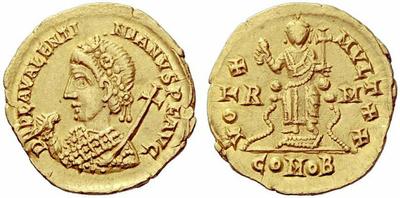
the emperor Valentinian III holding a mappa with the right hand and a long cross with the left hand.
Here are the main objects that we meet. Other elements such as an olive branch can be added. Small precision, the coins of the mint of Lyon (lugdunum) can show a globe (more a big ball than a globe, because the globes are often decorated with lines and points as they represent the world) at the base of the portrait. It is not an object, it is something like a fancy.
Read and understand legends and marks
Read a legend
The legends are in Latin, therefore it is quite difficult to clear some words if you have no knowledge in Latin. However I will give you some keys to successfully read these legends correctly. Note also that these legends are read in the direction of clockwise and sometimes they are retrograde. Retrograde legends are commonly found in the first and second century. All the legends of the obverse give the name of the emperor or empress. The vast majority of names end with "VS", except for women where we find an "A" example: HADRIANVS, CONSTANTINUS, CRISPUS ... and for women: IVLIA, FAVSTINA, GALERIA VALERIA, HELENA. A "U" is a "V" in Latin. Now that you know this, look for these letters and then go back to get the name of the emperor. If you use my image search engine, you have already identified this emperor, so you can delimit the other words around his name.
Now you are facing a problem: abbreviations. So here I list you the main abbreviations allowing you to read 90% of the coins very easily when you know these words. Here is the abbreviation in bold, the full name and its meaning:
AVG: AUGVSTVS, AVGVSTA = emperor, empress
AVGG: AVGVSTORVM = emperors (genitive plural)
CAES: CAESAR = emperor
COS: CONSVL = consul
D: DIVVS, DIVA = deified
DAC, DAC CAP = who defeated the Dacians for the first and Dacia captive for the second
F: FILIVS = son
FIL: FILIA = daughter
GER: GERMANICVS = who defeaed Germans
IMP: IMPERATOR = victorious general
P M: PONTIFEX MAXIMVS = great pontiff
P P: PATER PATRIAE = father of country
S C: SENATVS CONSVLTO = by decree of the senate
TR P: TRIBVNICIA POTESTAS = tribunitian power, renewed every year
SPQR: SENATVS POPULI = the senate and the people of Rome
One can have on a coin, for example: CAES or CAESAR noted, or else P M and PONT MAX on another, both designating PONTIF MAX ... also noted PONTIF MAXIM on certain coins. The engraver probably had to take into account the space available and ensure that the legend was provided and went from one end to the other. The more titles the emperor has, the more legends use short abbreviations. The legends of the reverse also have noted titles. The most common are IMP, P M, TR P, GER, DAC, S C ... S C is the most common of abbreviations noted on the reverse. We see these two letters generally in the field of the coin and very often on the setertii. Do not confuse S C with Sestertius, it has nothing to do. We also have Roman numerals I, II, III, IV, V, VI, VII, VII, IX ... which are added to titles like COS II TRP II. Do not confuse for example IV with the number 4, look what is before or after is COS IV or IVVENTVS? Pay attention.
For the reverse, think of the names of allegories and deities first. By using the search engine image of this site, you will know which is the allegory or deity represented and therefore its name: PAX, LIBERTAS, VICTORIA ... The list of allegories and deities is present below in this article with a chapter devoted to them. Also, I listed the other representations as well as the associated legends. So you know the words that we meet such as FEL TEMP REPARATIO for example.
It is important to note that legend breaks cut words, example: REPAR - ATIO or CAES - AR.
To be complete, it should be noted that some coins are called "anepigraph" because they have no legend to the obverse or the reverse. There may be words inscribed inside a shield or other element of the drawing too. All the details here if you want to deepen the subject: https://www.all-your-coins.com/en/blog/antique/nouvelle-codification-des-legendes.
Mint marks
Now let's go to marks. We are talking here about mint marks. These marks are the subject of a complete article. The mint marks are abbreviations of the name of the mint and mostly present on the reverse side to the exergue, below the ground line. We also see letters or symbols in the field of the coin that designate the issue, exactly, the serial strike phase of this type of coin (here is a perfect example of my remarks on the use of the word " type "at the beginning of the article). Not to be confused with words in the same places such as FORTVNA, FORT RED ... if you read the article on mint marks, you will know all the mints abbreviations and do not confuse them with others words; In any case, while waiting to know them, you can already search and compare your coin to find out what is marked.
Operation of a mint mark:
- Abbreviation of the name of the mint, example: SIS for Siscia.
- Letter of officina: Latin for a Western and Greek letter for an oriental mint. The position of the officina letter may vary and be in the field, most often in the case and at the beginning or end of the exergue mark. Sometimes other letters are added: SM for sacra moneta, M for moneta and OB for obryza (gold) (cup with which one verified the title of gold). Thus for the mint of Antioch one sees SMANT. S M for sacra moneta and ANT for Antioch, following a delta or alpha for example, thus designating the officina.
Western officina letters: P for Prima, first officina, S for Seconda, T for tertia, Q for quarta ... We can also have Roman numerals, I, II, III, IV ...
Eastern letters work on the same principle: A, B, ![]() ,
, ![]() ...in all the mints we number each officina. All this serves for issue control. Who hit what, when and how much.
...in all the mints we number each officina. All this serves for issue control. Who hit what, when and how much.
- One or more symbols in the field or around the mark, such as points, stars ... and used to identify the strike and issue phase of the coin.
Here is an example of coin with marks in the field on the obverse and on the reverse side as well as a mark in the exergue:
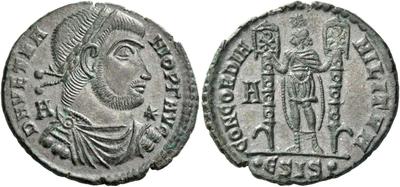
Maiorina of light weight, mint of Siscia, type CONCORDIA MILITVM. Détails ici: https://www.all-your-coins.com/en/emperors/romaines/vetranion
Let's analyze this coin. On the obverse, we have the letter A and in the field on the right ![]() . The heavy series has only the letter A and the light weight, A and
. The heavy series has only the letter A and the light weight, A and ![]() . So it's a light weight series. Here these two marks have nothing to do with the mint. On the reverse CONCORDIA MILITVM, the star above the emperor is part of the drawing it is not a mark.
. So it's a light weight series. Here these two marks have nothing to do with the mint. On the reverse CONCORDIA MILITVM, the star above the emperor is part of the drawing it is not a mark. ![]()
![]() SIS
SIS![]() is the mint mark, SIS for Siscia and
is the mint mark, SIS for Siscia and ![]() being the officina letter. The symbols around it are used to identify the issue (we know, at the moment, a little about the operation of these symbols). Finally the A in the field is also a mark but is not related to the mint. This may depend, on some coins these letters in the field are related to the mint and other letters are linked to a "series" struck (to summarize simply).
being the officina letter. The symbols around it are used to identify the issue (we know, at the moment, a little about the operation of these symbols). Finally the A in the field is also a mark but is not related to the mint. This may depend, on some coins these letters in the field are related to the mint and other letters are linked to a "series" struck (to summarize simply).
The chapter "The mints and their marks" below, greatly complements the subject and shows you the main marks and especially recurring abbreviations used for each workshop.
Denominations and their history
At the very beginning, the first coin was the liberal As, it was in bronze and theoretically weighed a Roman (libra) pound, actually much less (273grs). It was divided into duodecimal fractions (semi, triens, quadrans, sextans, uncia). In Rome, in 269 AD, the silver coin appears. Under the republic the coins were struck with the effigy of divinities, then one made the habit to vary their effigies.
Here is the evolution of the Roman monetary system:
1 Denarius = 2 As and a half
1 Sestertius = 10 As
At the II nd Century before J-C, after a general recast.
1 Deniarius = 16 As
1 Sestertius = 4 As
Under Cesar, the Sestertius is bronze and the gold coin appear.
1 Aureus (gold) = 25 Denarii 1 Denarius (silver) = 4 Sestertii
1 Sestertius (bronze) = 4 As
The coins were minted in the temple of Juno Moneta whose epithet, Moneta, will designate the coin. A commission of three members, the tresviri monetales, was in charge of the control of the strike, hence the reason for the presence of the letters S C on the Sestertii.
Under the empire, they only had the control of the coins in non-precious metals, gold and silver being under the control of the emperors.
From Augustus the coins are in the effigy of the emperor. The As, which had not been struck in the first century, resurfaced. The Sestertius is now brass.
1 Quadrans = 1/4 d'As, this coin will not last, due to successive devaluations.
1 As (bronze then copper)
1 Dupondius (brass) = 2 As, will appear briefly. 1 Sesterce (brass) = 4 As
1 Denarius (silver) = 4 sestertii
1 Aureus (gold) = 25 Denarii
So understand that a Denarius worth 16 As. To resume: before Augustus: 1 Aureus = 25 Denarii = 100 Sestertius = 400 As, same under Augustus: 1 Aureus = 25 Denarii = 100 Sestertii = 200 Dupondii (plural d Dupondius) = 400 As = 1600 Quadrans.
Under Antoninus appears the Antoninianus
Initially billon (silver alloy, bronze) it will lose virtually all of its silver capacity in the middle of the third century. From the beginning, until the empire, the weight of metal decreases constantly, the As goes from 273grs to 109, 27 grs then 9 grs, to finish at 2.3 grs under the low empire. The denarius contained less and less silver. For gold the Aureus goes from 8 grs to 7.30 grs under the high empire and 6.5 grs under the low empire.
For the duration of the empire, ordinary coins are the Aureus, the Golden quinarius or half Aureus, the silver denarius and the silver quinarius. For the bronze coins that the numismatists classify in AE we have the large bronzes AE1, the normal bronze AE2 and small bronzes AE3 and AE 4. There are multiple or large pieces of gold, silver and bronze called medallions (or multiple), very few because these coins were given as "honorific" to some people high up to thank them. These are therefore prestige strikes more than coins.
The reform of Diocletian in 294:
The Aureus (gold)
The Argenteus (silver) 3 grams.
The Follis or Nummus (silvery bronze)
Constantine the Great, then completely reformed the monetary system of the empire and created in gold:
The Solidus of gold
The Semissis or half solidus of gold
The Tremissis or triens
In silver:
The Miliarense or Millares
The Siliqua
The Half Siliqua
In bronze:
The Follis or Maiorina (AE1 or 2).
The Nummus or Centionalis or Half Maiorina (AE 3 or 4)
These coins persisted under the Byzantine Empire. The barbarians continued to strike the gold coins created by Constantine. Among the Merovingian Franks there is the "gold sou", the third of penny gold and the half siliqua or silver denarius. There is also Argenteus, Argenteii in the plural in 294:
1 Aureus = 25 Argentei = 100 Folles = 1250 Denarius. 1 Follis equivalent to 12.5 Deniers, mais a partir de 301 avec la crise économique, il vaudra 25 Deniers. Il va descendre de 1/32° de Livre a 1/42° puis 1/96° en 313.
In 318:
1 Follis = 100 Denarii. The Follis goes down until 348 to 1/96° of pound to 1/192° of pound. After 348 the Maiorina is graven to 1/60° of pound, there are divisions of 1/72°, the Half Maiorina is 1/120° of pound. Other types of coins exist, such as the silver Cistophor, the Hemissarion, the Hemidrachm, the Double Sestertius. The silver cistophor is used in Asia Minor and is worth 3 Denarii or 4 Greek Drachms. We are talking about several monetary systems, for a period of one millennium. Making a list of all types, with a conversion table, proves to be very complicated. The Romans adapted according to the region with the coins already in circulation. So there were several parallel monetary systems.
How to differentiate a denarius and antoninian? This is probably the question you ask yourself, it's simple: the denarius shows a laurel wreath and the antoninian a radiate crown. For women, the bust is placed on a crescent if it is an antoninian.
Allegories and divinities
This part lists most attributes of the main allegories, without going into the details provided. These details, you can find them in antoher article.
Abudantia : the abundance = Female character holding a cornucopia or pouring it.
Aequitas : the equity = Female character holding a scale, a scepter or a cornucopia.
Aeternitas : the eternity, stability = Female or male character carrying a sphere, a torch, a scepter and a phoenix or wearing the heads of the sun and the moon.
Annona : the annona = Female character wearing ears of wheat and a cornucopia.
Bonvs Eventvs = Naked figure carrying in his left hand a cornucopia and a sheaf of ears, in the right a cup of sacrifice which he pours on an alight altar.
Caritas = Two hands joined. More an image than an allegory.
Clementia : the clemency = Female character generally leaning on a column and holding a branch and a scepter.
Concordia : the concordia = Female character generally seated, holding a scepter and a cup of plenty, two standards or two joined hands.
Constantia : constancy, perseverance = Male figure helmeted and holding a spear. Right hand raised towards his face.
Fecvnditas : Fertility = Female character with children at her side or in her hands and holding a scepter.
Felicitas : felicity, prosperity = Female character holding scepter, cornucopia or a caduceus. Can hold two objects at a time.
Fides : fidelity, confidence = Female character who sows grain and holds a cup or a cornucopia.
Fides Militvm (Exercitvm) : loyalty of the army or its soldiers = Female character bearing scepter and standards.
Fortvna : Fortune, luck = Female character usually posed on a sphere next to a cornucopia and holding an oar. Sometimes holding an olive branch or a cup. May also have a wheel at his side.
Genivs : Genius = Naked male character with a cornucopia and a crown circle on his head. Sometimes with a coat. May also have an altar at his feet.
Hilaritas : Allegress = Female character sometimes accompanied by children holding a palm and a cornucopia, a scepter or a cup.
Honos : honor = Male character half naked, accompanied by virtue and holding a cornucopia with the foot on a helmet.
Indulgentia : indulgence, charity = Female character carrying a scepter and a cup.
Iusticia : justice = Seated female character holding a cup and a scepter.
Ivventas, Ivventvs : youth = Half-naked girl who sows an offering of grain and incense with a cup.
Jvcvnditas : Pleasure = Similar to Hilaritas and Laetitia.
Laetitia : joy = Female character holding a scepter and a garland.
Liberalitas : liberality = Female character holding a cornucopia and an abacus.
Libertas : freedom = Female character wearing a helmet and holding a scepter.
Moneta : the money = Female character wearing a long dress, holding a scale and a cornucopia. It will designate the coin from a certain period, it is Juno Moneta, from where the temple of Juno.
Nobilitas : the nobility = Female character carrying a scepter and a statuette (palladium).
Ops : opulence = Female character holding scepter and ears of grain.
Patientia : patience, tolerance = Female character holding a scepter.
Pax : the peace = Female character holding a scepter and an olive branch. Cornucopia, caduceus also, regular variants.
Pietas : piety, obedience = Veiled female character. Sometimes in front of an altar of sacrifice.
Providentia : providence, foresight = Female character holding a stick and pointing to a globe at her feet.
Pudicitia : chastity, modesty, the dignity of the housewife = Veiled character carrying a scepter. Can be seated.
Salvs : health, well-being = Female character wearing a cup with which he feeds a snake and carrying a scepter.
Securitas : security, confidence = Female character wearing a cup or scepter. Sometimes sitting on a chair, can be leaning on a column, cross leg.
Spes : hope = Female character carrying a flower. Raising her dress.
Uberitas, Ubertas :fertility = Female character holding a bunch of grapes or a purse or cornucopia.
Victoria : victory = Winged female character wearing a dress and holding a garland or palm. The palm symbolizes a victory in games.
Virtvs : Virtue, Courage = Male character carrying a spear and a shield. Generally the emperor. Coated with a cuirass and a parazonium, the parazonium is a short sword attached to a belt. This object is more a distinction for the superiors officers than a weapon, is on the left side. While the soldier's sword was on the right, the gladius.
Only CARITAS is not a character.
It is clear that most of these allegories, even if they are only the most common, are female figures. Most carry the same objects as the cornucopia and the scepter, which changes are the combinations and the visual positions of the characters. There is often the legend which gives the indication on the name (example: CONCORDIA). In the case of worn coin, one must simply identify the emperor and one can know who this allegory is; obviously, only if this emperor used an allegory very little used or knowing the date or following the titles on the obverse, we can know if (for example in case of legend indicating a significant victory) it is the victory. Right here:
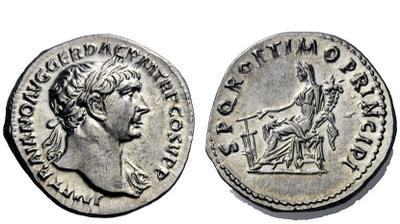
Who is it? She is a seated woman, with a cornucopia and holding a rudder or oar. This is Fortuna. We nevertheless see that there are two characteristic elements of this allegory, which lead us to identify it. This list is not exhaustive, but rather complete and shows the characteristics that come back regularly.
For the deities there are so many different representations that I will not list here but in a future article with more photos. You already find the list very extensive in the search engine, classified by deity. You will be able to see their attributes, positions... A male deity under the Empire could be feminine on a coin of the Republic. As myths often change because of the influence of the people around them, one can see a different representation at a certain period. Of course, during wars or phases of peace, people continue to exchange and it must be understood that all emperors are not from the same region, the empire is immense so we understand that some rites and beliefs evolve according to the regions .
To identify these divinities, some simple means, we know that if it is not an allegory, it is a deity, following the attributes and objects holding the character, we already have an indication of his specialty. To illustrate the problem, Jupiter may appear as a male character holding a lightning, but also be represented by a child on a goat or an eagle. It is therefore necessary to know the mythology and to define the origin of the coin which, according to the region and the date, can provide a means of identifying the character by knowing the local myths of the time. Another clue, an obverse with Laureate Emperor and with DAC GER in the legend, will not have a reverse with allegory Pax (peace) or a divinity unrelated to a victory. There may be a link, however. Imagine that after a major victory, the empire takes the local wealth, food and other, we can have a reverse with Abudentia (abundance), illustrating the fact that the defeated region brings many important things. It can be food or anything else, abundance is not necessarily synonymous with abundant food. Obviously, it is an image that is given, this is to illustrate a logic of the time and that we must obviously not rely on pictures but names. The cornucopia is filled with food. Identify a coin and especially a character is for, sometimes experts. They know precisely enough to find the real meaning of a coin, although many topics are open to discussion and they too may be wrong.
Striking techniques and accidental strikes
As you will see in the illustration below, "dies" were used to strike coins. Imagine a piece of metal, engraved and very resistant. There was a die called "sleeping" or "fixed" which was the one of the reverse and a die called "mobile" which was that of the obverse. The reverse corner was stuck in a block of wood, we put the blank (the blank of metal virgin of any inscription that will become the coin after the hit) on the reverse die and we presented, at the top, the obverse die then we hit with a hammer. Therefore, you can imagine that the slightly off-center strikes are quite normal. On the other hand, those called cap strikes and which therefore have a very strong decentering where only half or less of the drawing appears, is less common. I specify here that the strikes with a big decentering are very common in the imitations of time of low quality. Similarly, the Gallienus coins and particularly Tetricus I and II are very often largely off-center.
Hybrid: A coin with the obverse of one coin and the reverse of another, an obverse and a reverse that have nothing to do together. In this case, we must determine a die (all the same details, positions as on another coin) to know that it is the die of an original, that has been used with another die of obverse or reverse. More simply, when we identify for example the reverse of a coin for an emperor with his titles and we find this same reverse with another emperor on the obverse. The titles do not correspond to this emperor, so we see that it is a hybrid coin. Another scenario: imagine that we find a coin with a reverse having GER DAC as legend and that the emperor on the obverse has never fought or known conflict with the germans and dacians during his reign. So we have proof that the coin is a hybrid, a loan from an old reverse die to hit a coin. Hybrids are very rare.
Incuse: An incuse strike is said to be a strike where one side appears in hollow, the die called "sleeping" (that of the bottom also said fixed wedge) still has the coin struck previously, placed on him. A new blank is placed above the coin already struck. So there is an obverse in relief and on the other side the obverse in hollow. Visualize the top of the coin which is the embossed obverse which comes to print the underside of the second blank consequently hollow. This is very rare because under the eyes of the "hitter". Even if the hitter has the opportunity to see it, we still encounter this kind of mistake because the strikes were on a steady pace, at the chain and therefore leave little time to see the blank that had not been removed . Much more common: the reverse incus. Because the mobile die (of the obverse) held in the hitter's hand, still has the old coin that stuck on him. It is therefore the underside of this coin, so the reverse, which come print in hollow the top of the blank placed on the fixed die. Warning! The coins of the Republic are voluntarily incused. We can sometimes see incuse coins, reprinted .Ilustration:
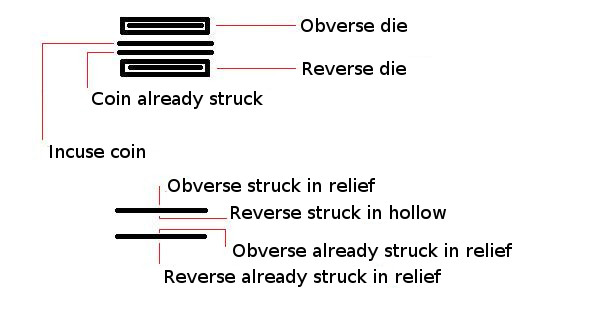
Shocked die : When the two dies hit in the void, this mean without blank between them. They mark each other, we find then on the coins they strike, elements of the reverse on the obverse and elements of the obverse on the reverse. In addition, some reliefs will be crushed, the highest details "those used to identify wear because the most exposed" do not stand out, example: the crown is very soft.
Die broken: By dint of striking, the die wears out but can also break, it can go from the hollow line on the die that leaves a line in relief on the coin, to an edge, or piece of die that comes off, leaving so a piece in relief. Drawing:
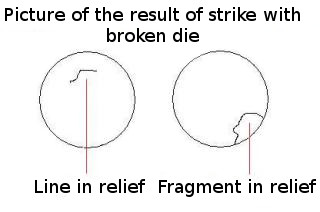
Blocked coin: A detail, a letter, an element of the portrait, appears only very little, erased. During successive strikes, a piece of metal may remain stuck in the die and thus plug a letter or part of the drawing.
Blanks errors:
Homogeneity errors with mixture metals: Often meets on the billons, we can see a copper color part and the rest, silver color. Do not be confused with fake ones.
Double weights: Much rarer for precious metals, is often found on the antoninians in billon of the third century.
Mints and their marks
I am giving you here, in addition to the information already given in the chapter "Reading and understanding legends and marks", under the heading "Mints Marks", a simple list of the most well-known marks for each mint. As well as the periods of activity of the mints. I do not list here all the symbols and all possible variants, because this is the subject of a complete article. This chapter is just to familiarize you with the letters written for each workshop.
Mints marks:
Alexandria (Egypt): 294 to 421 then 457 to 474 after J-C.
AL, ALE, ALE●, ALEA, ALEB, ALEX, ALEΔ, ALEΓ, CONSA , SMAL, SMAL● SMALA, SMALA●, SMALB, SMAL●B, SMALB●, SMALΔ, SMALΔ●, SMALΓ
Ambianum (Amiens, France): 350 to 353 after J-C.
AM, AMB, AMB croissant pointé, AMB●, AMB croissant, *AMB, AMB*, ●AMB*, *AMB croissant, *AMB croissant pointé, AMB palme, ●AMB palme, croissant pointé AMB couronne, AMBI.
Antioch (Antakiah, Turkey): 217 to 611 after J-C.
AN, ANA, ANT, ANTA, ANTOB, SMAN, SMANA, SMANTA.
Aquilea (Italy): 294 to 324 then 334 to 430 after J-C.
AQ, AQOB, AQP, .AQP, AQP., .AQP., AQPS, AQVI, AQVIL, AQVILP, .AQVILP, SMAQ, SMAQP, .SMAQP, .SMAQP..
Arles (France): 313 to 475 after J-C.
A, AR, ARL, ARLA, CON, CONST, FPAR, KON, KONSTAN, PAR, PAR., P*AR, PARL, PARL., PARL*, PAR.L, PCON, PCONST, SARL.
Barcino (Barcelona, Spain): 409 to 411 after J-C.
BA, SMBA.
Camuldunum (Colchester, England): 287 to 296 after J-C.
C, CL.
Carthage (Tunisia): 296 to 307 then 308 to 311 after J-C.
K, KAR, KART, PK, PKA, PKB, PKT, PKP, PKS.
Constantinople (Istanbul, Turkey): 326 to 453 after J-C.
CON, CONA, CONA*, CONOB, CONS, CONS., CONSA, CONSA., CONSA*, .CONSA., CONSP, CONSPA, .CONSPA., CP.
Cyzicus (Kapuh Dagh, Turkey): 260 to approximately 475 after J-C.
CVZ, CVZA, CVZIC, CVZICA, CVZICENA, CYZ, CYZICEN, KV, KVZ, KY, SMK, SMK///, SMKA, SMKA., .SMKA., *SMKA.
Heraclea (Marmara Ereglisi, Turkey): 291 to 474 after J-C.
H, HER, HERAC, HERACA, HERAC.A, HERACI, HERACL, HERACLA, HERACL.A, .HERACL.A (point en dessous), HT, SMH, SMHA, SMHA., .SMHA., .SMHA, SMHA*.
Londinium (London, England): 287 to 325 then 383 to 388 after J-C.
AVG, AVGOB, AVGPS, L, LD, LG, LI, LN, LON, ML, MLL, MLN, MSL, PLN, PLON.
Lugdunum (Lyon, France): 15 before J-C to 90 after J-C then 195 to 196 after J-C ad 254 to 423 after J-C.
CPLG, FPLG, LPLG, *LPLG, LVG, LVGD, LVGOFFP, LVGP, LVGP*, LVG.P, LVGPS, MPLG, PLG, .PLG, *PLG, PLG*, *PLG., PLVG, PLVG*, PLVGD, PPLG, PPLG., RLPG., RPLG.
Mediolanum (Milan, Italy): 250 to 275 then 364 to 475 after J-C.
DM, MD, MDOB, MDPS, MED.
Nicomedia (Izmit, Turkey): 294 to 474 after J-C.
MN, MNA, N, NA, NIC, NICO, NIK, NIKA, NIKA*, SMN, SMNA, SMNA., .SMNA., SMNA*.
Ostie (Italy): 308 to 313 after J-C.
MOST, OST.
Ravenna (Italy): 404 to 475 after J-C.
RAV, RV, RVPS.
Roma (Italy): 289 to 40 before J-C then 20 before J-C, 476 after J-C.
R, RBP, RFP, R.F.P, RM, RMP, R.M.P, RMP*, ROM, ROMA, ROMOB, RP, R.P, R..P, R*P, RPRIMA, R.PRIMA, SMR, SMRP, VRB, VRB ROM.
Serdica (Sofia, Bulgaria): 272 to 282 then 303 to 308 and 313 to 314 after J-C.
SD, SER, SERD, SMSD,
Sirmium (Sremska Mitrovica): 320 to 326, 351 to 364 then 379 and 393 àto 395 after J-C.
ASIRM, ASIRM., SIR, SIRM, SIROB, SM.
Siscia (Sisak, Croatia): 260 to approximately 390 after J-C.
ASIS, .ASIS, .ASIS., ASIS*, .ASIS*, A.SIS, ASISC, .ASISC, ASISC., ASISC*, *ASISC, *ASISC., ASIS D, ASISR, .ASISR, ASISV, DASISC, S, SIS, SISC, SISC., SISCPS, SM.
Thessalonique (Salonica, Greece): 298 to 460 after J-C.
COM, COMOB, OES, SMTS, SMTSA, TE, TES, TESA, .TESA, .TESA., *TESA, TESOB, TH, THES, THS, THSOB, TS, TSA, TSA., TSAVI.
Ticinium (Pavia, Italy): 274 to 326 after J-C.
BT, PT, QT, ST, T, TT.
Treveri (Trèves, Germany): 294 to 395, 408 to 413 then to 430 after J-C.
ATR, BTR, PTR, .PTR, PTRE, .PTRE, SMTR, SMTRS, SMTRP, SMTRS, TR, TRB, TRE, TROB, TRP, TRP., TR.P, .TRP., TRP*, TRPS, TRS.
So you see that we find the same letters for each mint: TR for Trier, AMB for Ambianum ... But some exceptions as I said earlier in the article: "SM for moneta sacred, M for Moneta, OB for Obryza (gold) (cup with which one verified the title of gold) "from where the marks SMANT ... But also the mark CONS or CONST or still CON for the mint of Arles, which can seem illogical. Why use AR or ARL and then CONS? It is the name of the city of Arles which changed under Constantine I in: Constantia, obviously produces an immediate change of the mint mark using the first three or four letters of the name of the mint. So you know that if you see the CONS mark this coin has not been minted before Constantine I. But it can be confused with the Constantinople mint, which uses the same letters.
Provincial coins
How to differentiate a provincial coin from an imperial coin? Provincial coins contain, always a legend in Greek, except for the colonies of Latin law. Some coins may have on their reverse the mention S C and have a Latin legend, as for the bronzes of Antioch, style can make the difference. The name of the city, so-called ethnic is mostly inscribed, sometimes abbreviated, often ending with the letters Ω (sometimes written as a w) and N.
There are also the titles awarded to the city and the names of magistrates as well as their charges:
ΣΑΡΔΙΑΝΩΝ: name of a city.
ΕΠΙ Γ Ι ΚΡΙΣΠΟΥ ΑΡΚ: name of the magistrate and his office.
ΔΙΣ ΝΕΩΚΟΡΩΝ: honorary title awarded to the city.
Except for the first coin, where we regularly find the name of the city on the obverse, the name is on the reverse. Another element: if you see a coin with a typically African animal, it is probably a provincial coin. I say probably because we see many elephants or lions on the coins of the empire as well as numbers of African animals on the coins of Philip or Gallienus. There is always something in the legend, the style, the representations, which indicates that the coin is provincial. These coins circulated in the region where they were minted and thus are imbued with style, lifestyle, common visual elements, local fauna. Most of the colonies are ancient Greek colonies; they have for a long time been seen circulating, the Greek coinage. In this sense and this logic, the Romans have adapted and the types of coins have changed, appear then imposing coins by their diameter or weight. The smaller divisions corresponded to the quarter of assarion. Larger modules are mounted at 60 mm as for large bronzes, of PTOLEMEE. Note that we also call the "Great Bronzes" Chalques, Dichalques, Octochalques, etc. according to their diameter. One can sometimes doubt a type since a coin can be "wide blank" and therefore be closer to another type, likewise for "short blanks", always refer to the diameter and the weight and this for any type of coin. There is not one, but several monetary systems, according to the regions. Egyptian coins circulated even in certain cities. You will understand that make a list of types and their equivalence with other coins, is a very heavy work. There is one type that is often found: the Tetradrachm or Drachm SYRO-PHENICIAN, money in silver or billon often presenting on the reverse, an eagle. There may be presence of this animal also on the obverse under the portrait of the emperor. The term Drachm refers to Greek silver coins. Be careful not to conclude that they are still silver. Like the denarii, they find themselves in billon and therefore with a bronze aspect, because of their low silver content. Provincial coins are struck from the end of the Republic to Aurelian.
Five important points:
1: There is sometimes a point in relief or a hole in the middle of the coins, sometimes off-center. The point results from the compass, serving to delimit the zone of the legend in the die. One line, the other end of the compass, is sometimes visible at the area of the legend. The hole is the trace of the turnery of blank, so not on the die, but on the future coin.
2:
A common abbreviation, COL for COLONIA, followed by the name of the city. Example COL NEM for COLONIA NEMAUSUS and therefore designates Nîmes, COL VIM for Viminacium. We find these abbreviations separated or glued.
3: We find coins cut in half, for example, to make a half Dupondius, cut a Dupondius in two or four to make four ''As".
4: Animals can represent a country. For example, the crocodile represents Egypt, but there is not a "specific" animal for each country. There are also animals on non-provincial coins, they are most often legendary animals, example, the wolf of Romulus and Remus. The wolf can be represented without Romulus and Remus, it is a character in full. Beware, the presence of the wolf does not exclude a provincial strike, it is also present in provincial coins. Animals on the provincial coins may designate the emblems of the legions too, example for Gordian III we see on a Dupondius struck in Upper Moesia, on the reverse, the Tyche with on his left an ox representing the seventh legion and on his right, a lion representing the fourth legion.
5: Tyche is a deity of fortune, prosperity, and destiny of a state or city. Not to be confused with Fortuna. She is wearing the wall crown. Many Greek cities have their own "Tyches", they are often associated with animals (see point 4). She was particularly venerated as the protective goddess of the city in Antioch or Alexandria in particular.
States of conservation
Now that you have identified your coin, it should be properly evaluated. And, for that, it is necessary to estimate its state of conservation. Let's look at the table below:
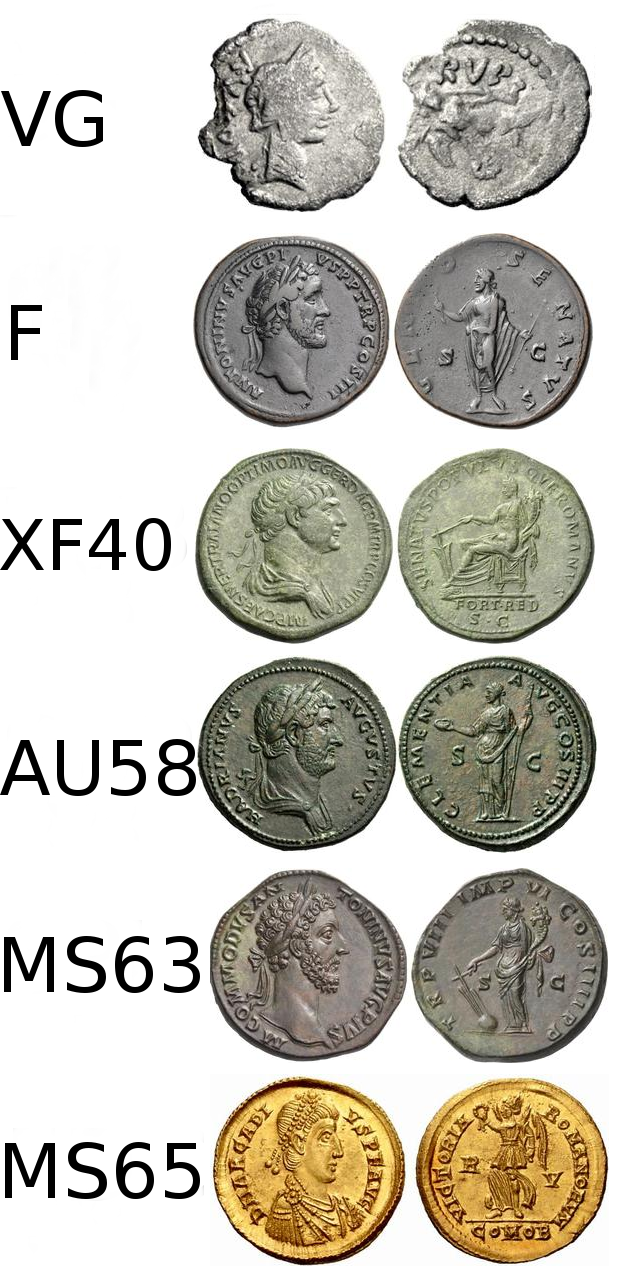
Classification criteria:
- State F: very worn coin, one distinguishes some elements allowing to identify the coin. Rest of portrait and legend.
- State VF: we distinguish the whole of the drawing and a very large part of the legend. However, most of the reliefs are worn.
- State XF 40: Everything is readable and the design includes almost all of its details with low wear on the most prominent points.
- State AU 58: All the details are there, very little worn.
- State MS 63: The coin is almost perfect, we note some tiny details slightly worn.
- State MS 65: Perfect coin.
You can refer to the article "New quotes serious and realistic "https://www.all-your-coins.com/en/blog/moderne/nouvelles-cotations-serieuses-et-realistes". Which joins the previous lines. Finally, I must tell you that in my opinion (and I am not the only one) the MS 65 state is exaggerated as a term for an antique coins. We give this rank considering that we are talking about a perfect coin. Or rather almost perfect because if you look closely at the coin of the table, we can imagine even better. I mean, we can imagine that the hair stand out better, as well as the wings of victory. As in the article in the link above, I would like to point out that: the state of the dies, the striking quality (more precisely the striking angle of the batter) all this helps to get out a coin with an extraordinary visual or a coin with details that stand out less well. This therefore joins the debate I develop in the article link: do we consider a coin as MS 65 if it is simply kept in its original state, regardless of the striking quality? Or should we have a coin in its original state and struck perfectly? It's subjective. Including on modern coins, you will see some coins graded MS 65 by some and MS 63 by others. I add: I have already seen a nummus Constantius II with large remnants of ''original shiny'' yes, you read correctly. A coin that was stuck and compressed in the middle of others, all locked up in an ancient vase. Imagine a bright coin in its almost complete and orange-bronze color. In this case, should we also include shiny as a criterion? In my opinion, no, it's a plus. It is for all these reasons that the term MS 65 is ridiculous in my opinion. Especially since this term means: Mint State, referring to modern dies, made according to meticulous techniques that give a perfect result. This is impossible in ancient times, as the techniques (albeit already evolved) are far from what we know today and even since the 19 th century.
Books and their references
This chapter is not used to identify your coin but to understand its referencing. When you have a coin, you look everywhere at what is said about that coin. So what does C.12 or RIC 214 mean? These two abbreviations are those that you will almost always find and that is why I describe them here. C is for Cohen and RIC for Roman Imperial Coins. The first book is French and very old. The RIC is a series of 10 volumes covering the whole of the Roman coinage. Each of these books or volumes lists the coins existing for each emperor. The numbers indicate the exact described coin. Thus, the RIC 177 for Antoninus Pius designates an aureus with on the obverse the bust of Antoninus the Pius laureate and draped, legend ANTONINVS AVG PIVS PP TR P XII and on the reverse Aequitas holding a balance and a cornucopia with legend COS IIII. You will also see var indications, example RIC 1547 var, this indicates that there is a variant of the RIC 1547 type. In other words, a small element differs from the RIC 1547 as an object position, TR P instead of TR POT. These variants are either already listed in these books or mentioned as modern discovery and therefore variants of the types already referenced. The best-known books are almost all obsolete and contain some errors (referencing a coin which does not exist, description error, forgetting etc). This is why I created this site to gather and verify the existence of each coin with photo as proof. Thing that any work can not do without exceeding 100 volumes as the number of photos needed would be huge. In addition we can add each discovery easily without having to republish a book or corrigenda.
Here is a list of the main works cited during sales:
C = Henry Cohen "Description Historique des monnaies frappées sous l'Empire Romain".
RIC = Roman Imperial Coins.
RPC = Roman Provincial Coins.
RRC = Roman Republic Coinage.
Banti = "Sesterzi e medaglioni classificati secondo il sistema Cohen. I grandi bronzi imperiali" and
"Corpvs Nvmmorvm Romanorvm" from 1973 made with Simonetti.
Bastien = Pierre Bastien "le monnayage de l'atelier de lyon".
Calico = "The Roman Aureii Catalog".
Göbl = Robert Göbl "Die Münzprägung des Kaisers Aurelianus".
Plant = Richard Plant "Roman Silver Coins, 2006" and "Roman Base Metal Coins, 2006".
Seaby = "Roman Silver Coins Vol II, Third edition, revised by Robert LOOSLEY, Londres, 1979",
"Roman Silver Coins Vol III, Londres, 1969" and "Roman Silver Coins Vol IV, Second edition, revised by David R. SEAR, Londres, 1982".
SEAR = David R "Roman Coins and their values, Londres 2000".
With this, you have 99% of the books cited, it may happen that in addition to these books we quote other works, especially in the case of a sale of a coin from a treasure. Example: Carson "The Hama Hoard and the Eastern Mints of Valerian and Gallienus".